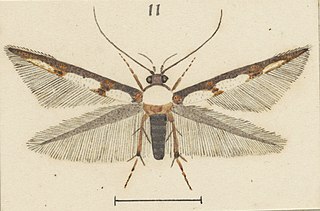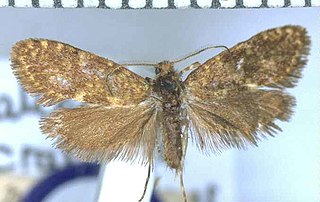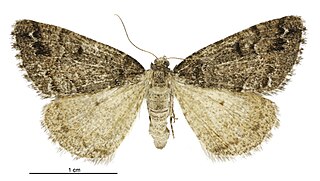
Asaphodes is a genus of moths in the family Geometridae erected by Edward Meyrick in 1885. This genus is endemic to New Zealand and species within this genus are found throughout New Zealand including the North, South and Stewart / Rakiura Islands.

Sabatinca chalcophanes is a moth of the family Micropterigidae. This species is endemic to New Zealand and is found in the North Island apart from Northland and in the South Island apart from in the east, south of Queen Charlotte Sound. The adults of this species are on the wing from November to April and as a result of this long period it has been hypothesised that this species has two broods. The preferred habitat of this species is in damp lowland forest. The larval host species are foliose liverwort species including Hymenophyton flabellatum.

Aristotelia paradesma is a moth of the family Gelechiidae. It was described by Edward Meyrick in 1885 and is endemic to New Zealand. This species has been observed on both the North and South Islands. The larvae feed on Coprosma species creating and living in stem galls. The adults are on the wing from November to March and are attracted to light.
Scythris niphozela is a species of moth in the family Scythrididae. It is endemic to New Zealand. It is classified as "At Risk, Naturally Uncommon" by the Department of Conservation.

Stathmopoda aristodoxa is a species of moth in the family Stathmopodidae. It is endemic to New Zealand. It is classified as "At Risk, Naturally Uncommon" by the Department of Conservation.

Tingena is a genus of the concealer moth family (Oecophoridae). This genus is endemic to New Zealand.

Proteodes melographa is a species of moth in the family Depressariidae. It is endemic to New Zealand and has been observed at Mount Arthur and in the Nelson District. It inhabits forest in the alpine zone. The larvae of this species feeds on native beech trees.

Mallobathra is a genus of moths belonging to the family Psychidae, and are bagworm moths. This genus was first described by Edward Meyrick. It is endemic to New Zealand. The type species of this genus is Mallobathra crataea.

Tingena anaema is a species of moth in the family Oecophoridae. It is endemic to New Zealand and has been collected at Lake Wakatipu, Invercargill and Stewart Island / Rakiura. The adults of the species are on the wing in December.

Tingena chloritis is a species of moth in the family Oecophoridae. It is endemic to New Zealand and has been found in the South Island. Larvae of this species feed on leaf litter. The adults of this species are light flyers and are attracted to light.

Tingena homodoxa is a species of moth in the family Oecophoridae. It is endemic to New Zealand and is found in the southern parts of the South Island. It inhabits open grassy slopes and is on the wing from November until January.

Tingena letharga is a species of moth in the family Oecophoridae. It is endemic to New Zealand and has been observed in Otago. Adults are on the wing in December and January.

Tingena nycteris is a species of moth in the family Oecophoridae. It is endemic to New Zealand and has been observed in the North and South Islands. This species inhabits native forest and scrubland and adults are on the wing from October to January.

Tingena ophiodryas is a species of moth in the family Oecophoridae. It is endemic to New Zealand and has been observed in Canterbury.

Tingena siderodeta is a species of moth in the family Oecophoridae. It is endemic to New Zealand and is found throughout the country. This species prefers to inhabit native forest and scrubland but has also been found to be common in cultivated landscapes. The larvae are litter feeders and have been observed in Kanuka and Manuka forest. The adult moths are on the wing from October to February and are day flying but have also been trapped at night.

Pseudocoremia colpogramma is a species of moth in the family Geometridae. It is endemic to New Zealand.

Cnephasia incessana is a species of moth in the family Tortricidae first described by Francis Walker in 1863. However the placement of this species within the genus Cnephasia is in doubt. As a result, this species may be referred to as Cnephasia (s.l.) incessana. This species is endemic to New Zealand.

Cnephasia latomana is a species of moth in the family Tortricidae first described by Edward Meyrick in 1885. However the placement of this species within the genus Cnephasia is in doubt. As a result, this species may be referred to as Cnephasia (s.l.) latomana. This species is endemic to New Zealand.

Cnephasia microbathra is a species of moth in the family Tortricidae first described by Edward Meyrick in 1911. However the placement of this species within the genus Cnephasia is in doubt. As a result, this species may be referred to as Cnephasia (s.l.) microbathra. This species is endemic to New Zealand.

Trachypepla is a genus of moths of the family Oecophoridae. It was circumscribed in 1883 by Edward Meyrick. The species within this genus are indigenous to Australia and New Zealand.



















